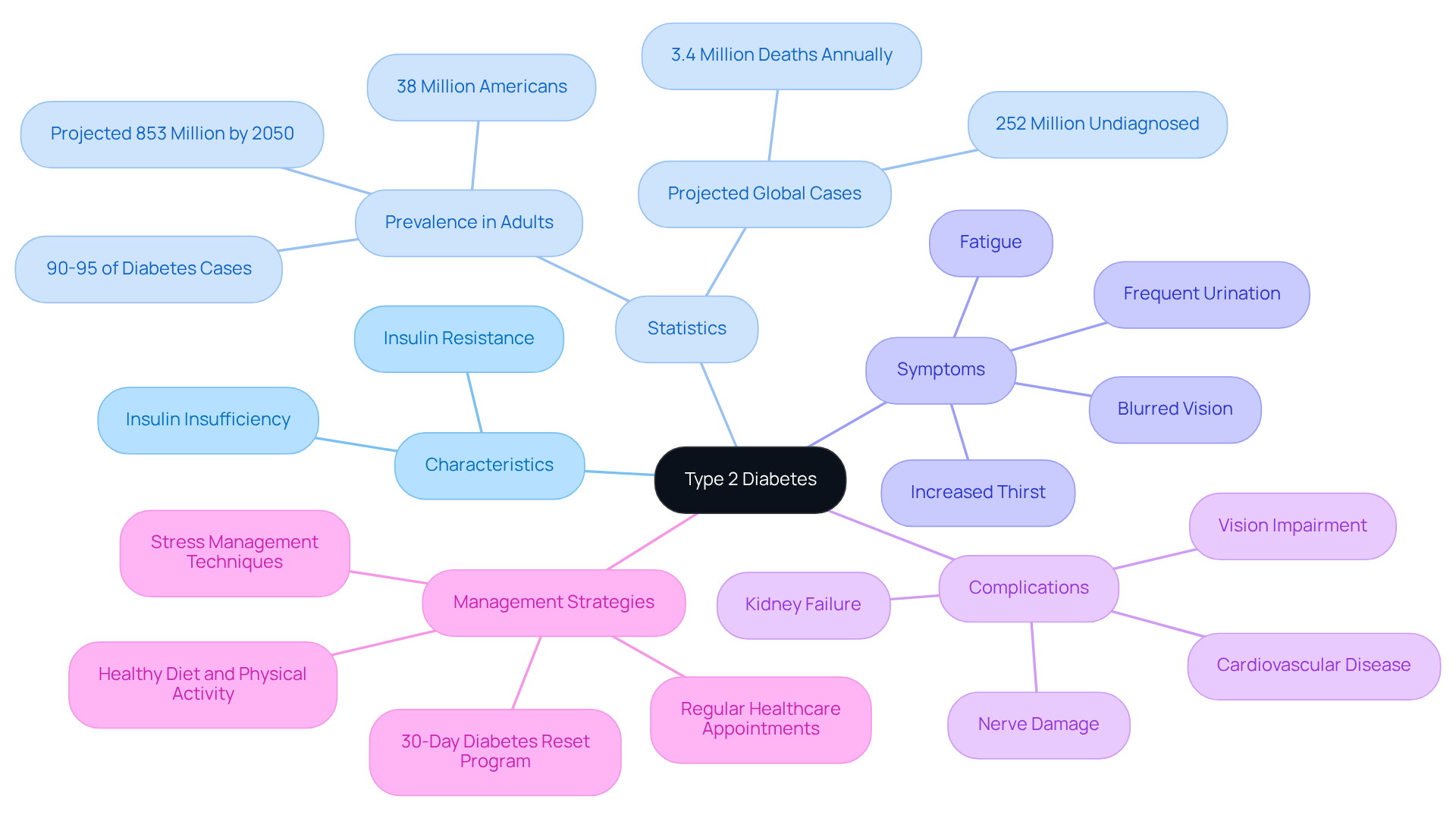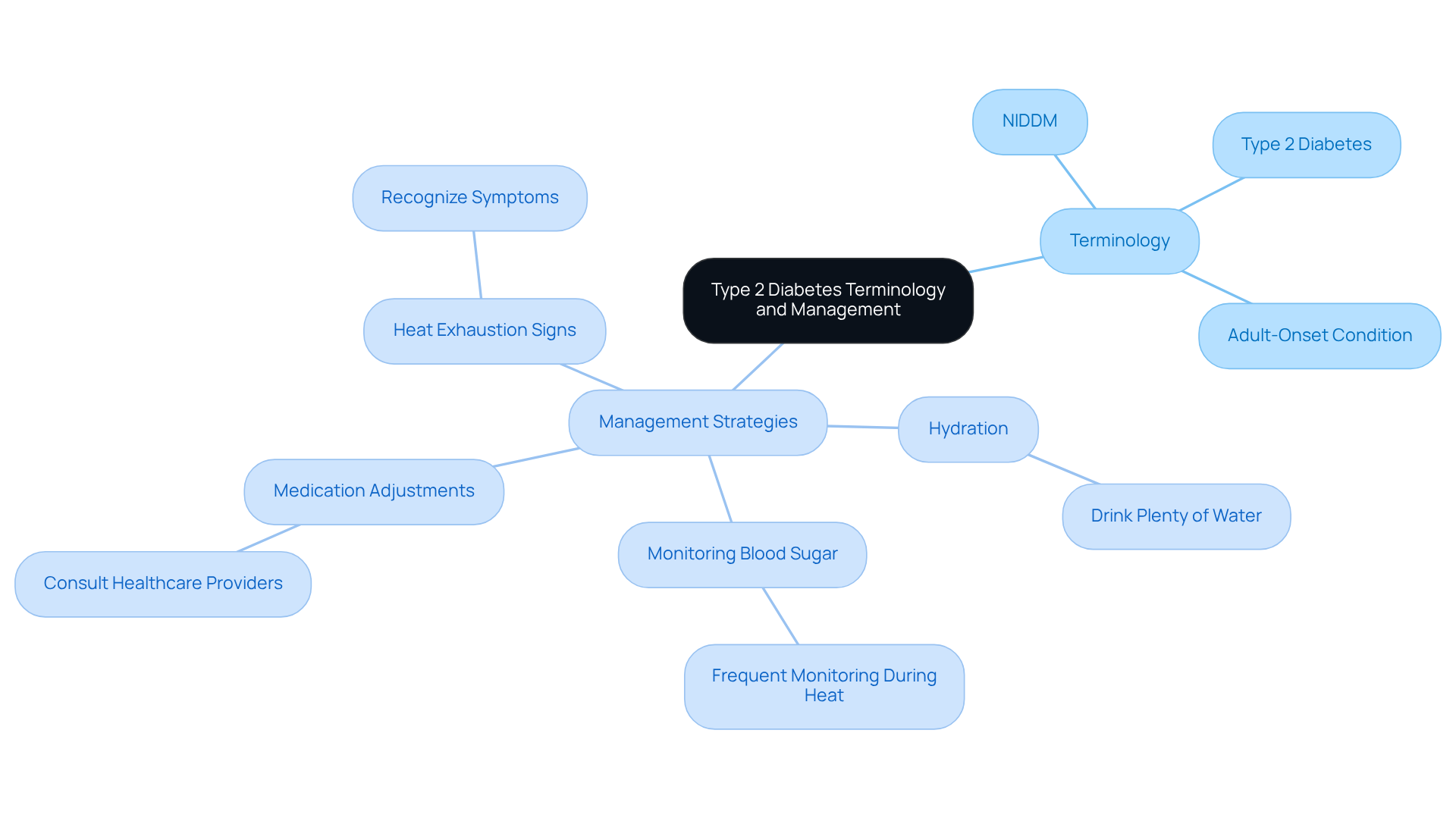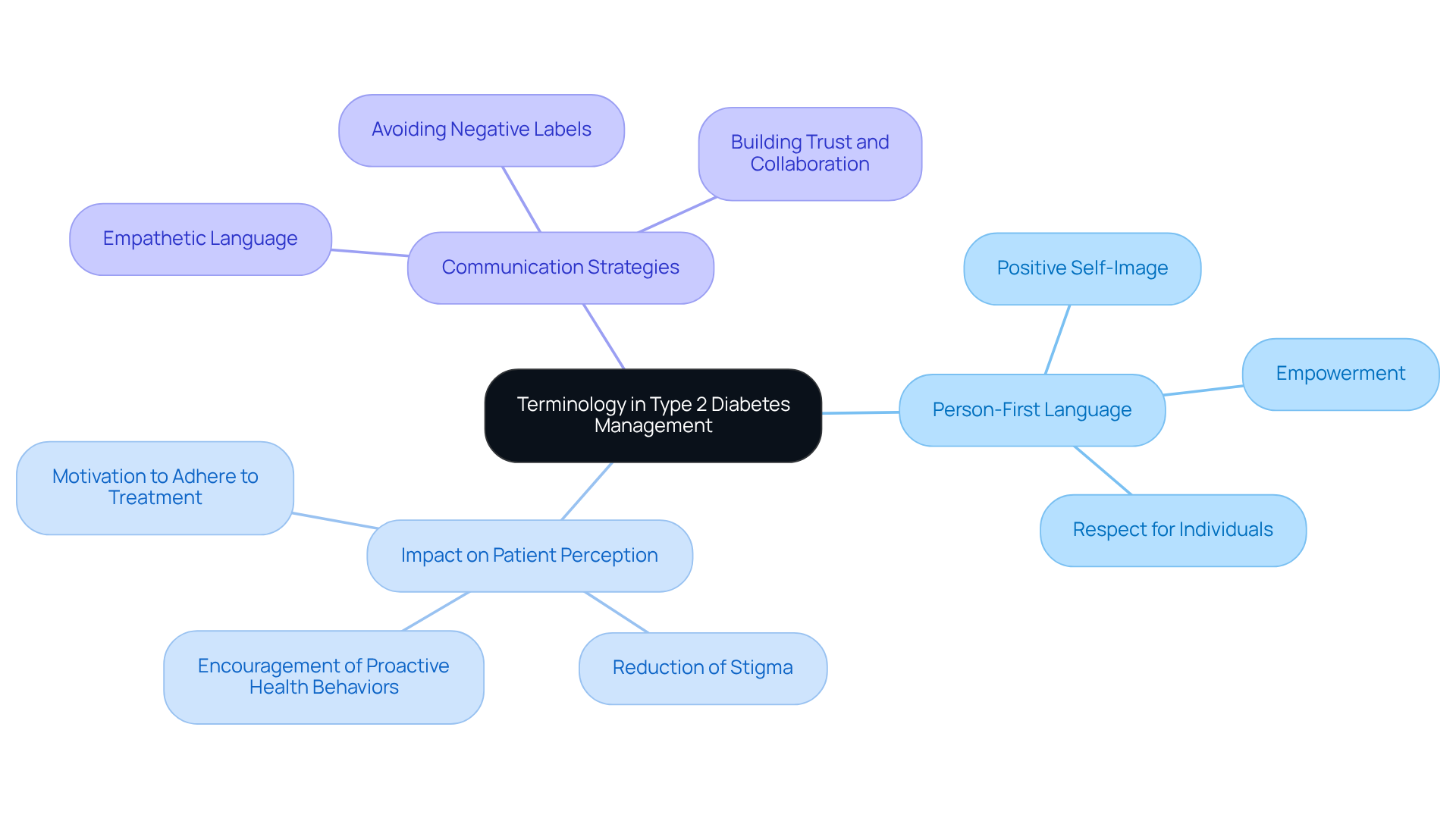Overview
The article highlights that type 2 diabetes, often referred to as a chronic metabolic condition, is characterized by insulin resistance and elevated blood glucose levels. This condition is increasingly impacting younger individuals, largely due to rising obesity rates. It’s important to recognize that this understanding is crucial for effective management and prevention. The terminology we use can significantly influence how patients perceive their condition and the strategies employed for treatment. Many patients find that ongoing education and awareness in both clinical and community settings are vital for their journey toward better health. Together, we can foster a supportive environment that encourages healthier living.
Introduction
Understanding the terminology surrounding type 2 diabetes is essential for navigating the complexities of this widespread condition. It’s important to recognize that with rising rates of diagnosis among younger populations, the language we use to describe type 2 diabetes has evolved. This evolution reflects not only changing demographics but also new treatment approaches.
How can a deeper grasp of these terms empower individuals to manage their health more effectively and combat the stigma often associated with diabetes? Many patients find that exploring these nuances sheds light on the condition itself and highlights the importance of communication in fostering a supportive environment for those affected.
Define Type 2 Diabetes: A Comprehensive Overview
Another name for type 2 diabetes is a chronic metabolic condition that many people face, characterized by insulin resistance and a relative insufficiency of insulin. This leads to increased blood glucose levels, and it’s important to recognize that another name for type 2 diabetes represents around 90-95% of all cases, making it the most common variety. Traditionally, it has been associated with adults, but alarming trends reveal rising incidence rates among younger populations, largely driven by increasing obesity rates.
Have you noticed symptoms like heightened thirst, frequent urination, fatigue, or blurred vision? If so, you’re not alone. Many individuals experience these challenges. If left unmanaged, another name for type 2 diabetes can result in serious complications such as cardiovascular disease, nerve damage, kidney failure, and vision impairment. Current statistics show that over 38 million Americans are living with this condition, often referred to as another name for type 2 diabetes, and projections indicate that by 2050, approximately 853 million adults globally will be affected.
Understanding the intricacies of what is another name for type 2 diabetes is essential for effective management and prevention strategies. Many patients find that grasping the connections between insulin resistance and their health can empower them to take control. Remember, you are not just a statistic; your journey matters, and support is available.
Consider exploring the 30-Day Diabetes Reset program, which offers guidance and community support. Taking small steps today can lead to significant changes tomorrow. Together, we can work towards a healthier future.
Explore Alternative Names and Terminology for Type 2 Diabetes
Type 2 diabetes, which is another name for type 2 diabetes, can feel overwhelming. Historically, the term ‘adult-onset condition’ reflected the typical age of onset, but with rising obesity rates and more inactive lifestyles among younger people, this label has become misleading. NIDDM highlights that many individuals initially do not require insulin therapy, though progression may necessitate it. Understanding these terms is essential for both healthcare professionals and patients, as they greatly influence treatment strategies and educational efforts. It’s important to recognize that the change in terminology mirrors the evolving nature of this condition, with current research showing a rapid rise in another name for type 2 diabetes, particularly among younger populations. This evolution not only reflects changing demographics but also impacts how the condition is diagnosed and managed, underscoring the importance of ongoing education and awareness in both clinical and community settings.
Alongside grasping the terminology, it’s crucial for those with Type 2 diabetes to prepare for heat waves. Staying hydrated is vital; drinking plenty of water throughout the day helps maintain a normal body temperature and supports overall health. Many patients find that monitoring blood sugar levels more frequently during extreme heat is essential, as heat can affect these levels. Consulting with healthcare providers about possible adjustments to medications, particularly insulin, is recommended to avoid dangerous fluctuations. Dressing in light-colored, loose-fitting clothing can aid in cooling the body, while limiting sun exposure during peak hours is crucial for safety. Recognizing the signs of heat exhaustion can empower individuals to react swiftly to prevent serious health issues. Dr. Jason Shumard emphasizes that understanding these terms and preparedness strategies is vital for everyone involved, as they significantly impact treatment strategies and educational efforts. For a comprehensive approach, consider referring to Dr. Shumard’s Checklist for Heat Wave Preparedness, which outlines essential steps to stay safe during extreme heat.
Understand the Importance of Terminology in Type 2 Diabetes Management
The terminology used in blood sugar management is crucial in shaping patient perceptions and experiences. It’s important to recognize that using person-first terminology, such as ‘person with a health condition’ instead of ‘diabetic,’ encourages a more positive self-image and reduces stigma linked to the condition. This thoughtful change in communication honors the individual beyond their diagnosis and cultivates a sense of empowerment. Many patients find that terms like ‘prediabetes’ and ‘at risk for developing the condition’ inspire them to embrace proactive health behaviors, prompting lifestyle changes before the illness emerges.
Research indicates that the choice of words significantly influences a patient’s motivation to adhere to treatment plans and make necessary lifestyle adjustments. For example, employing encouraging expressions can inspire confidence and improve self-care practices among patients. Conversely, negative language can lead to feelings of shame and demotivation, obstructing effective management of the condition.
Psychologists stress that communication is vital in healthcare interactions, promoting a person-centered approach that prioritizes empathy and understanding. By nurturing a supportive atmosphere through thoughtful word selections, healthcare providers can greatly enhance patient involvement and outcomes in managing another name for type 2 diabetes. Ultimately, the impact of person-first language extends beyond mere semantics; it plays a vital role in shaping the overall experience and quality of life for individuals living with diabetes.
Conclusion
Another name for type 2 diabetes encompasses a range of terminology that reflects our growing understanding of this condition. It’s important to recognize that by acknowledging these terms, both individuals and healthcare providers can cultivate a more informed and supportive approach to management and treatment. The significance of terminology goes beyond definitions; it shapes perceptions and influences the experiences of those living with diabetes.
Many patients find that the rising incidence of type 2 diabetes, especially among younger populations, can be daunting. Key insights highlight the critical role of language in fostering a positive self-image. The shift from terms like ‘adult-onset diabetes’ to more inclusive language encourages proactive health behaviors and empowers patients to take charge of their health. Furthermore, the discussion on heat wave preparedness underscores the need for comprehensive management strategies that consider both physical and environmental factors affecting blood sugar levels.
In conclusion, understanding and utilizing appropriate terminology in diabetes management is essential for enhancing patient care and outcomes. As the landscape of type 2 diabetes continues to evolve, embracing person-first language and fostering supportive dialogue can significantly impact the lives of those affected. It is crucial for both individuals and healthcare professionals to engage in ongoing education and awareness, ensuring that everyone has the tools and knowledge necessary to navigate this complex condition effectively.
Frequently Asked Questions
What is type 2 diabetes?
Type 2 diabetes is a chronic metabolic condition characterized by insulin resistance and a relative insufficiency of insulin, leading to increased blood glucose levels.
How common is type 2 diabetes?
Type 2 diabetes accounts for approximately 90-95% of all diabetes cases, making it the most common variety.
Who is primarily affected by type 2 diabetes?
While traditionally associated with adults, there is a rising incidence of type 2 diabetes among younger populations, largely driven by increasing obesity rates.
What are the common symptoms of type 2 diabetes?
Common symptoms include heightened thirst, frequent urination, fatigue, and blurred vision.
What are the potential complications of unmanaged type 2 diabetes?
If left unmanaged, type 2 diabetes can lead to serious complications such as cardiovascular disease, nerve damage, kidney failure, and vision impairment.
How many people are affected by type 2 diabetes in the United States?
Over 38 million Americans are living with type 2 diabetes.
What are the projections for type 2 diabetes globally by 2050?
Projections indicate that approximately 853 million adults globally will be affected by type 2 diabetes by 2050.
Why is understanding type 2 diabetes important?
Understanding the intricacies of type 2 diabetes is essential for effective management and prevention strategies, empowering patients to take control of their health.
What resources are available for individuals with type 2 diabetes?
The 30-Day Diabetes Reset program offers guidance and community support for individuals seeking to manage or prevent type 2 diabetes.


